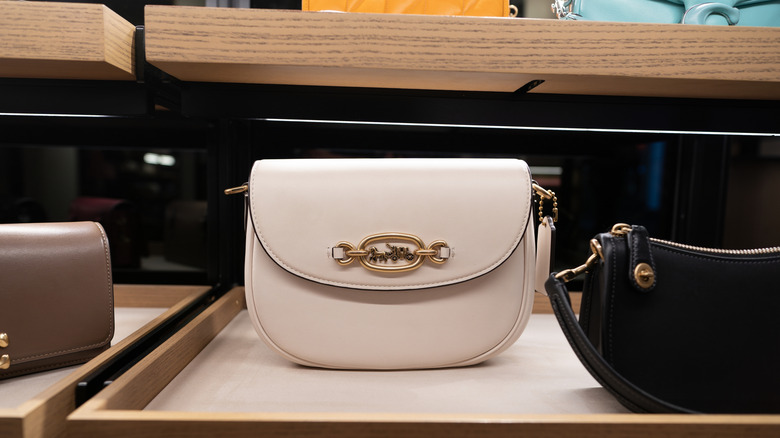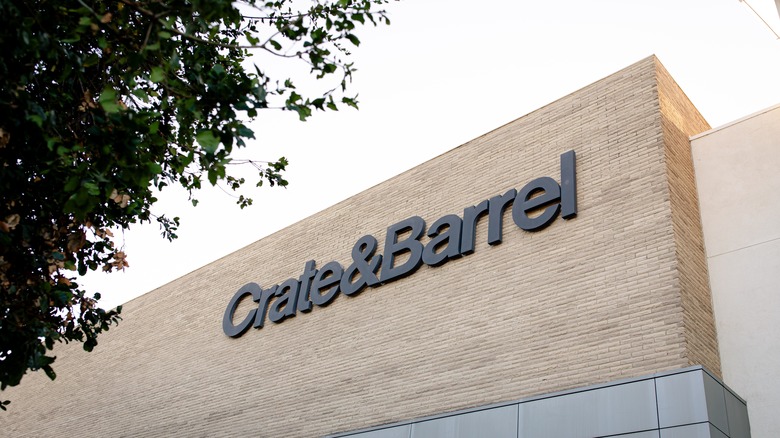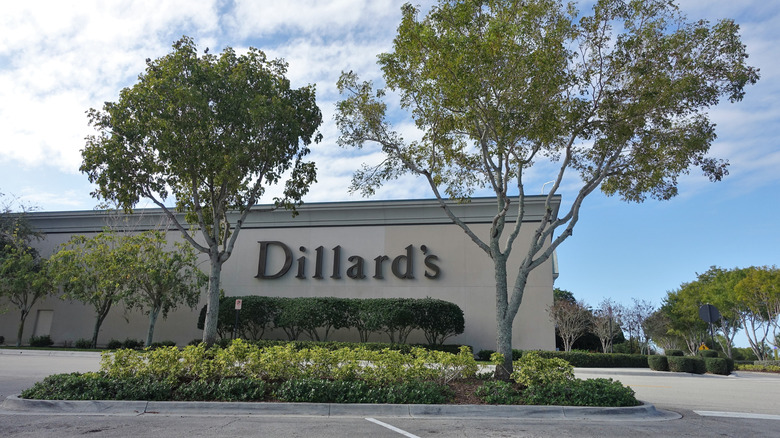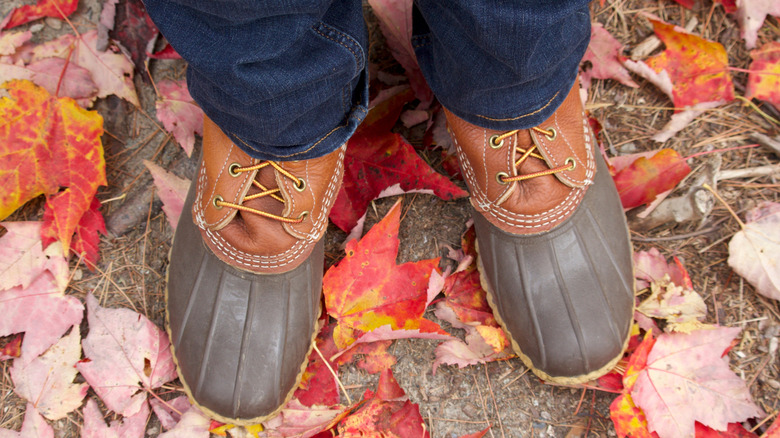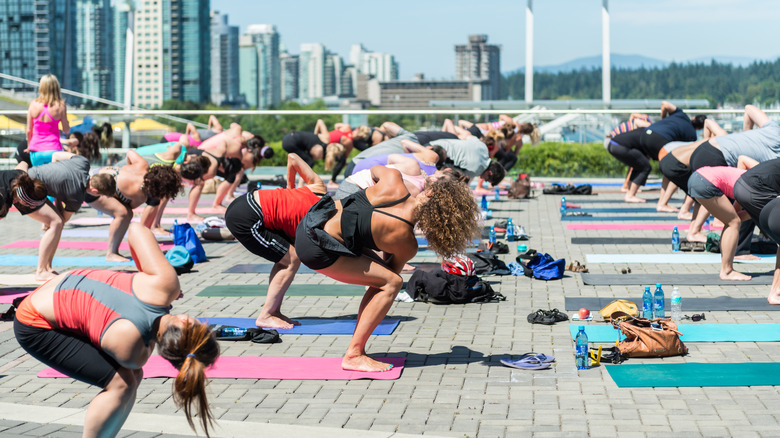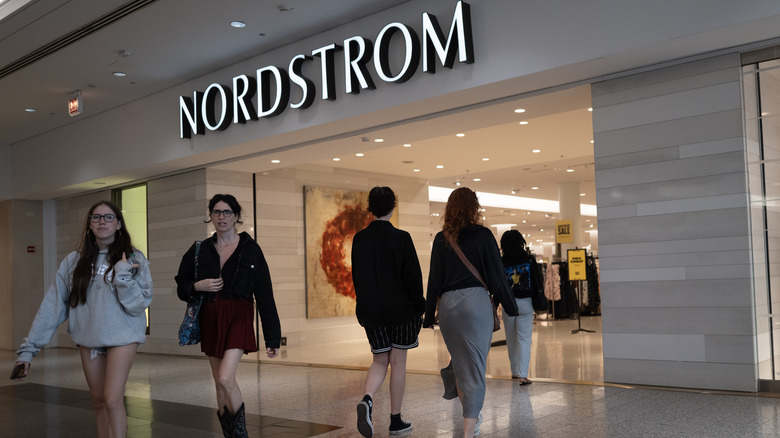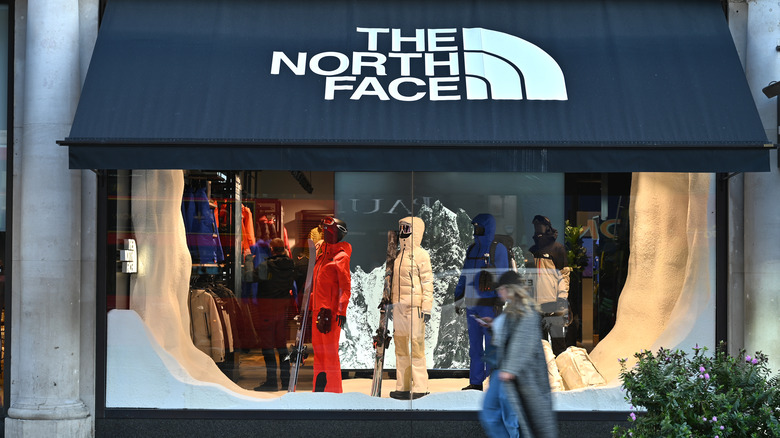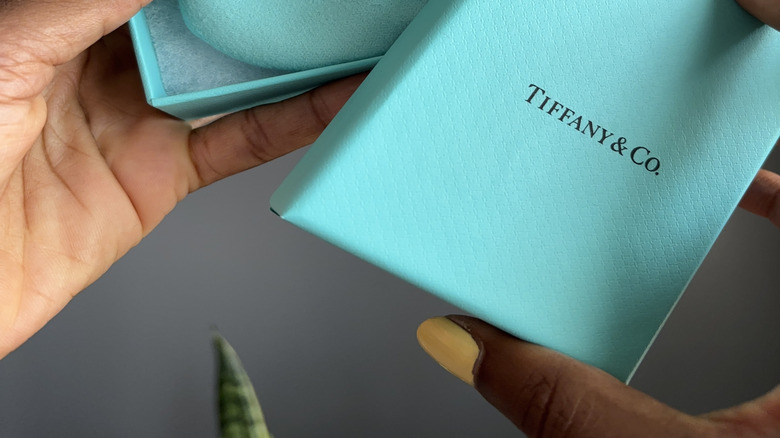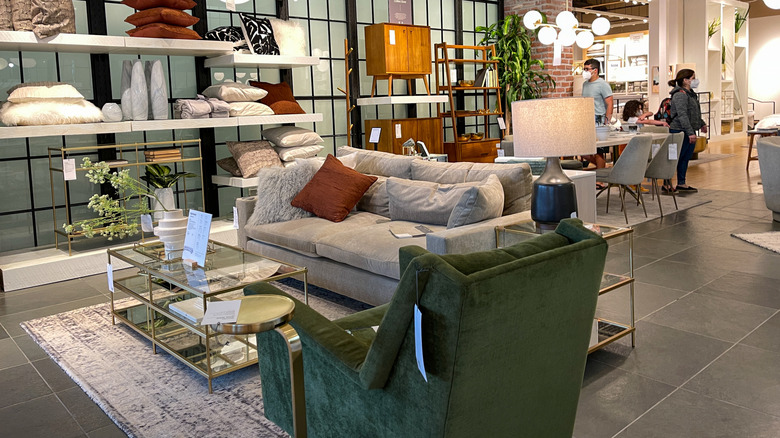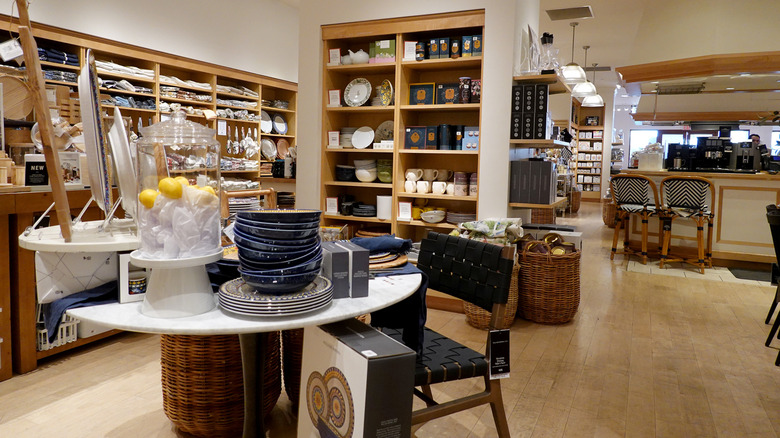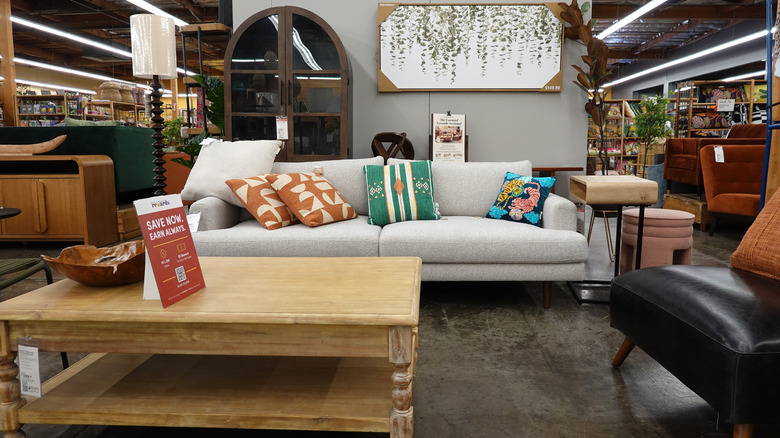14 Popular Stores That Middle Class Shoppers Treat As A Status Symbol
Being middle class is, in some ways, proof of having achieved the American Dream. That dream is undeniably interwoven with consumerism. After all, there has to be some visible identifier of achievement. This is especially so if someone's childhood was devoid of desirable name brand items. Often, those items are the clothes people wear, the furniture they place in their homes, and the gadgets on their desks and in their kitchens.If someone feels entitled to brag about being able to shop at the stores listed below, they're probably (at least) middle-class. Lower-income households are less likely to be able to afford to shop there, and the wealthy have their preferred luxury brands. Economists have long warned about the shrinking of the middle class, which you wouldn't expect based upon interviews with Americans. According to a Pew survey, few people describe themselves as anything but middle class — perhaps hinting at the broad success of these companies.
Apple
Major middle-class retailers like Walmart and Target offer 11-inch iPads for less than $300. So, purchasing Apple products won't impress the wealthy who aren't motivated to parse which iPhone offers the best value for their money. But it still scores points with the middle class. Obviously, it's not always the ability to pay high prices for a device that makes middle-class Apple customers feel like they owe themselves a pat on the back. Interestingly, one of the major attractions of Apple products is their look.
Apple has a reputation for elegant design thanks to its nearly 30 years of benefitting from the creations of designer Jony Ivy. It was Ivy who gave birth to the look of the iPhone, iPad, iMac, and iPod. Ivy's clean, minimalist approach to industrial design springs from the many seeds planted by Germany's legendary Bauhaus art school that operated between the world wars. The school emphasized a product's function and frowned upon unnecessary embellishments. The approach was a deterministic marriage of art and industry. Buying Apple products allows aspirational middle-class consumers to embrace their love of technology while feeling good about their preference for beautiful items.
Coach
Coach has been around since 1941, long enough to be a familiar status symbol to several generations. However, instead of languishing in nostalgia, the company has aggressively promoted itself to today's younger generations. The result is that middle-class purchasers can own an item with a respected heritage that's also updated and trendy. The challenge has been returning Coach to its roots. It was a leather goods maker long before it became a fashion house. The company prided itself on producing items that would endure.
Today, that spirit is found in its Coach (Re)Loved program. The company's workshop of artisans repairs Coach items and finds ways to repurpose material. The company says you can help the environment by purchasing a (Re)Loved item rather than a new product. Coach cites a Columbia University study that says making a used Coach purchase could represent as much as a 76% reduction in the production of carbon. You can also turn in a suitable pre-owned Coach item in exchange for credit.
Coach has successfully built a new image. It's no longer in danger of being seen as an out-of-date, stodgy relic of past decades. Instead, it has positioned itself as more than just another fashion house. It promotes itself as a community of craftspeople who care about the environment and as a status symbol for people who want to do the right thing for the planet.
Crate & Barrel
Middle-class houses and apartments are available in a variety of styles, so it helps to have a furniture store with versatile contemporary furniture suitable for different settings. For example, Crate & Barrel's line of apartment-sized couches allows you to furnish a studio apartment with items from the same store where others are decorating a spacious family room.
There's nothing flashy about Crate & Barrel. Rather, its furniture seems to represent solid, middle-class dependability disguised as a warm, comforting accent chair. And that accent chair or any other living room furniture is likely to be featured in a calming, low-key color similar to what's popular among higher-end furniture stores and their wealthier clients.
Crate & Barrel scores extra points with the middle class through its team-ups with prestigious names in the world of interior design, such as Athena Calderone. The products from the studios of big designers would normally be out of the reach of the middle class. However, these collaborations allow purchasers to get a taste of world-class design at a more accessible price.
Dillard's
Dillard's has long been the store that solidly middle-class people frequented to avoid the lower middle-class shopping at JCPenney. A Dillard's bag signals that even on a budget, you have an appreciation for quality. There's a reason you won't see in Dillard's all the discount signs you see in JCPenney. Dillard's keeps a close watch on its inventory through sophisticated software to lower the risk of being stuck with large amounts of slow-selling items. Without the need for an abundance of discount pricing, Dillard's maintains the look and feel of a more expensive department store.
It helps that years ago, Dillard's chose to set up shop only in the malls most financially capable of weathering economic setbacks. So, when heavily-indebted mall owners began shutting down, Dillard's avoided tainting its image through association. In August 2025, the company showed just how particular it is about the malls it chooses by buying its own mall in Longview, Texas. Like its new mall acquisition, most Dillard's locations are in the south where the company enjoys a reputation like Nordstrom has for decades in its native northwest.
The chain stays relevant by linking itself with today's influencers, designers, and celebrities. Retail Dive reported that in 2024, the chain announced the addition of an in-house design shop focusing on the work of a select group of designers. And in 2023, the Atlanta store was the site of a fashion show hosted by one of the cast members of "The Real Housewives of Atlanta."
LL Bean
Even when they're just setting a picnic table at the local park, some people like to dress as if they have deep pockets. LL Bean gives you that outdoorsy look, while making you appear as if you belong to Old Money. The store's aesthetic seems rooted in American mythos even if its clothing today is mostly made in China. That trust fund style used to be more commonly referred to as the preppy look, as in prep school. LL Bean represents that look so well that it earned mention in the 1980 bestselling satirical book The Official Preppy Handbook.
Of course, the preppy look began with the truly wealthy, not the middle class. But that's part of the allure. People with regular jobs can dress like the 1%. That would partially explain the ongoing popularity of the store's signature duck boots or Bean Boots. Their looks are an acquired taste. They're well-suited for early morning hunters trudging through swamps, bogs, and marshes, but even in winter, they're a jarring sight on someone in the middle of downtown making a mid-day coffee run.
Lululemon
Does your body really care where you purchase your yoga pants? No, but the person on the mat next to you in yoga class might. Sporting Lululemon indicates to everyone that you're a serious student of yoga, even if your downward dog looks as if it rolled over and died. Lululemon is all about being aspirational. It wants to inspire people to care about their physical and mental health and become better people — and the brand cashes in on that messaging. That sort of outlook aligns well with the standard middle-class initiative of striving for excellence.
The brand began with a focus on female customers but has expanded its activewear clothing line to embrace males who are equally concerned about looking good in yoga class. The company uses its marketing campaigns to connect people within a community using their shared interest in a healthy lifestyle and love of Lululemon as the draw. Community acceptance has always been a hallmark of a true middle-class family. Few people may know their next-door neighbor's name, but through social media, they can connect with someone of like values across town who just bought the same yoga mat.
Maui Jim
Appropriately, sunglass maker Maui Jim sponsors professional sporting events like tennis and golf tournaments that the middle class enjoys. The idea is to get the middle-class consumer to link Maui Jim sunglasses with an active lifestyle. Wearing the brand is one way to self-identify as a lover of sports, whether you participate or not. The company's name also clearly indicates its link to the beautiful island of Maui, located in America's most exotic state and a perennial vacation wishlist entry for the middle class.
The brand is Hawaiian in more than just its name. The company was founded on Maui. So, the name can carry an air of the exotic for many Americans. After all, Hawaii is a long way from the front steps of most mainland Americans.
Maui Jim's sunglasses employ proprietary technology that supposedly enhances your viewing experience. The scenery is allegedly clearer and the colors more accurate. In other words, the world looks better. Who could turn down a chance to look at things that way?
Nordstrom
The various smaller Nordstrom locations across the country can't match the legendary customer service of the flagship New York location, but that doesn't mean they can't try. And their on-hand personal stylists and personalized attention for each shopper make middle-class people feel they're in a vintage Hollywood romantic comedy where the heiress shops for a new hat while the sales clerk holds her poodle. Not many modern stores offer the personal attention Nordstrom gives. That commitment to outstanding customer service induces loyalty by providing things the middle class (or really anyone) craves, such as attention and appreciation.
Ordinarily, the money of the middle class isn't enough to gain them entry into hyper-exclusive fashion ateliers and bespoke fitting rooms. But Nordstrom aims to treat everyone who walks through its doors as if they're VIPs. A good example is the store's on-call stylists found at the typical Nordstrom store, not the discounted Nordstrom Rack outlets. Personal stylists will work with you to find the cut, material, and colors that work best for you. So, why wouldn't middle-class people continue to shop where they're treated like the wealthy?
The North Face
It isn't a prerequisite to climb the north face of any mountain in order to wear The North Face outdoor gear. But that logo lets people know that you shouldn't be mistaken for just another mild-mannered suburban commuter. There's a love of danger about you lurking beneath that fleece. It's reasonable to assume most people didn't become familiar with the brand by hanging out with rock climbers. Instead, they became acquainted after seeing the store's clothes becoming popular as streetwear.
The North Face's legitimate claim as one of the preferred outfitters for many of the world's most daring adventurers makes it appealing as the appropriate clothier for entrepreneurs, dreamers, and other risk takers trying to navigate dangerous business climates rather than howling, bitterly cold high-altitude storm systems. The North Face enhances this call to action through partnerships with pro athletes who can testify to the worthiness of the product and to the grit it takes to achieve a goal. The North Face is a continuing reminder to the middle class that they don't have to remain middle class. They can leave base camp and push themselves forward to an even higher level.
Sleep Number
There are people who know that the only thing better than talking about how they scored their latest office promotion is humble-bragging about the sleep they had to sacrifice to earn that corner office. Then they can top their own story by telling everyone how their aching back wouldn't leave them alone until they finally gave in and bought a Sleep Number bed.
Smart beds touch two primary interests of the middle class, namely, technology and health. They also emphasize highly-prized personalized attention. Because the Sleep Number bed allows you to adjust the firmness setting to accommodate your preferences, it acts as a 24-hour valet ready to do your bidding regardless of the hour. In addition to firmness, the Sleep Number bed monitors and adjusts the temperature on your side of the bed, further ensuring you have a great night's rest. The price of one of their mattresses can span from a little over $1,000 to more than $10,000. The price range is wide enough to assure middle-class buyers that they're getting something most people can't afford while still remaining within their budget.
Tiffany & Co.
It may seem puzzling to list Tiffany & Co. on a list of places where the middle class shops. However, Tiffany has made an effort to attract the middle class by broadening its range of items available at more affordable prices. For example, for less than $500, a person can walk away with a genuine Tiffany bracelet, like the Tiffany T. The metal clasp is in the shape of Tiffany's initial. So, once the bracelet sparks a conversation, dropping the name of the world famous retailer into the discussion is easy without seeming like you're trying to impress people.
You get to choose the color of the bracelet's cord, and one of the colors is Tiffany Blue, the registered trademark color of the firm. You've seen the color even if you've never seen the bracelet. Tiffany's gift boxes are in Tiffany Blue, helping everyone who knows about jewelry to immediately identify the jeweler and recognize your good taste. When someone see a Tiffany Blue box, they have no idea whether the contents cost you a middle-class $500 or an ultra-wealthy $50,000.
West Elm
West Elm sports that mid-century modern look of low furniture with clean lines and fashionably understated looks. It's not your grandmother's Queen Anne furniture that's still being sold at the big furniture stores in town. Instead, it's a version of 1960s grown-up suburban hipness transported and transmuted for the modern world. The only things missing are the ever-present cigarette (thank goodness) and a cocktail. In short, West Elm represents sophistication, but sophistication on a budget that the mid-tier income earner can afford.
West Elm offers its rendition of classic furniture silhouettes, making it simple to achieve a mid-century look without visiting every vintage shop in a three-state radius or dropping a bundle at auction. However, West Elm updates the vintage look so there's no danger of inadvertently turning a living room into a museum display. Mid-century modern is historically linked with the rise of the American middle class following World War II. Its use of new materials and a distinct color palette helped foster the growing optimism about the future then abundant in middle America. Using furniture from West Elm signals an up-and-coming family with good things on the horizon.
Williams Sonoma
The interior design of a Williams Sonoma store is intended to transport you away from your everyday suburban cares to a place where you're a skilled chef with a tool for every dish and enough time to indulge in the creation of herb-encrusted masterpieces. Leftover college dorm cookware isn't going to impress anyone. But people who purchase quality items from Williams Sonoma can astonish their friends even if they only use their kitchen as a place to eat delivery.
The prices are higher than what you would find in the kitchenware department of an ordinary retailer, but that's part of the appeal. Having imported French and Italian pots and pans in the kitchen is the middle-class culinary equivalent of having a garage full of Mercedes-Benzes and BMWs. If a person had received these long-lasting cooking utensils through a family inheritance, they would probably take the items for granted. But when someone is the first in their family to own French Mauviel copper cookware, it's a declaration of status.
World Market
Traveling the globe is expensive. World Market, with its eclectic summary of cultures and styles, offers people the chance to decorate their homes in a way that makes it look like their passports must have more stamps than Ernest Hemingway's. The items aren't necessarily created in the part of the world they represent. They may simply find inspiration in a faraway culture. World Market refuses to divulge the names of their manufacturers, so there's no way of knowing if that rattan chair, basket light pendant, or handblown glass came from distant shores or from the factory around the corner.
A person may not be able to brag that they picked up a certain charming little item at a backstreet market in Morocco. But they could still establish an atmosphere in their home of someone who knows their way around the globe. This is important because the middle-class doesn't want to be seen as the kind of people who have never left the city limits. A well-traveled person is often thought to possess such desirable qualities as sophistication and adventurousness. If someone can link those personality traits to themselves for the price of a so-called Moroccan-inspired rug, instead of the cost of an international flight, so be it.


